It’s time we got out of the RV and began to explore this town. We’ve been holed up in the RV with tires, maintenance, other projects and we need to get out of this tiny tin box and see what there is to see in Sactown - as we’ve heard it called. We have had a chance to visit the Railroad Museum which we thought was super and today we decided to tour the Capital and the Leland and Jane Stanford home, about 4 blocks from the Capital. A nice compact tour.
When we had visited the Railroad Museum last week, we found ourselves in a parking garage and, at the end of our visit, 8+ hours later, we had a $13.00 bill. Our other choice was to feed the parking meters: $.25 for 12 minutes or $1.25 per hour - but you have to keep returning to the meter to feed it. No one I’ve spoken to says that parking in Sacramento is cheap although one person told us to park more in the residential section. So, today, we took her advice and drove through the residential section and found: 2-hour parking, 1-hour parking, no parking, or parking meters that wanted $.25 for 12 minutes. Then we rounded a corner and found: $5.00 for all day parking. Whoo-eee. Our kind of parking. And, the good part is that it was at least 1 mile away from the Capital so we could get our daily walk in. And, the bad thing is that it is 1 mile away from the Capital so we had to walk a long way to get there. Well, we’re going to walk anyway, so why not walk through the residential section to get a feel for the homes in this area?
Our first stop was the Capital where we signed up for a tour which began at the rotunda where we could look up through the dome.
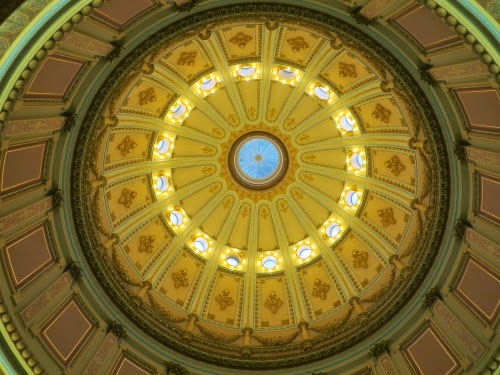
This capital is modeled on the US Capital in Washington, DC. But the Senate and House are decorated in red and green like the House of Commons and Lords in England. Here’s the House in its green

and the senate in its red.
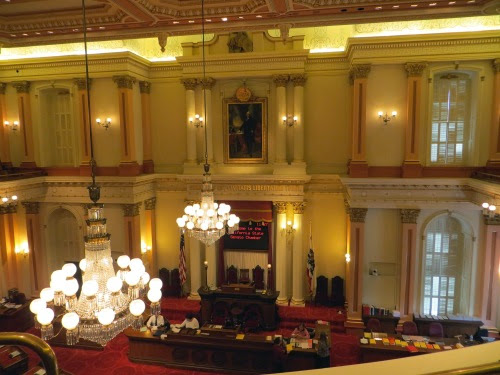
Here’s a picture from the 1800’s and note the piles of papers and books on the desks. Boy, does a computer make a desk less cluttered - oops, maybe I’d better look around my desk before I say that. What happened to the old ‘paperless’ society?
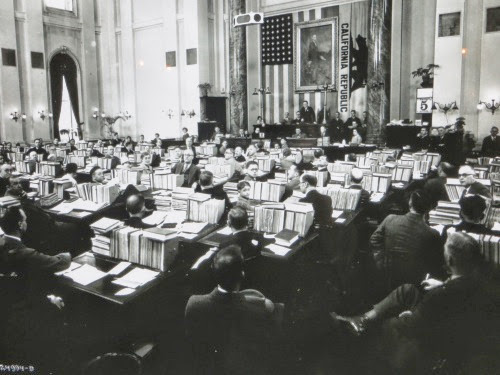
When they redid the building in the 1980’s they had to remove, clean and replace each one of the 300,000 mosaics in the tile floor. They took complete detailed pictures of each section of tile and numbered them all so they could get them back into the right place.
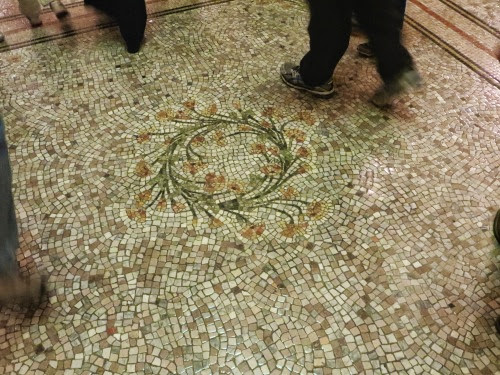
When the original tile floor pictured below was put designed and put into place, the creators did not sign it but left their ‘mark.’ Note which 2 tiles are different than the others in the pattern. There are other sections in the floor where they also reversed the tiles as their ‘signature.’ Can you find their ‘signature’ here in this picture?
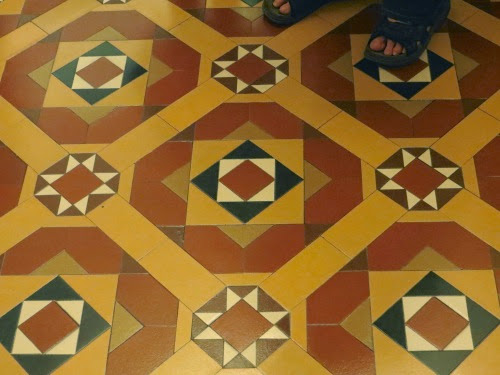
Each governor gets a stipend to get his picture done to hang in the halls of the Capital. Most are pretty prosaic, men in suits beside a desk with a flag. Jerry Brown chose a different design.
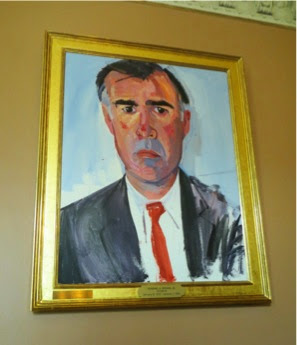
One of the greatest migrations in America occurred during the Dust Bowl when hundreds of thousands of people migrated to California for jobs in the fields. In the Capital, there was a pictorial display of how 3 artists pictured this migration, highlighting Woody Guthrie, Dorothea Lange and John Steinbeck. Here is the iconic picture of the Dust Bowl and Great Depression taken by Dorothea Lange.
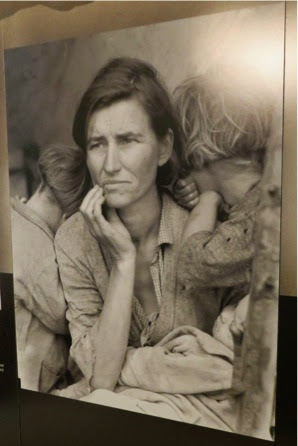
In 1935 the Farm Security Administration hired photographers to document the lives of struggling farmers. Lange was one of these and was hired to accompany economist Paul Taylor throughout California. One day, after a month in the field, she was returning home when she passed the camp of pea pickers. She drove on but turned back after 1/2 hour, returning to the camp ‘as if a homing pigeon.’ Here she found Frances Owens Thompson, a 32-yr old widow with 7 kids. Her first husband had died in 1931 and in 1936, the time of the picture, she and her companion, Joe, had traveled to Nicomo to pick peas. The car had broken down and she was waiting in the tent for Joe to get back from town where he had gone to get the car fixed. Lange began snapping pictures and this is her 6th and final one. It became the iconic image of the Depression.
Thompson remained anonymous until the 1970’s when she told a newspaper publisher. In 1983 she had a stroke and her son appealed to the newspapers for funds to help with medical expenses and $35,000 came in. Her tombstone reads: ‘ Migrant Mother: a legend of the strength of American motherhood.’
The Capital also has taken preserved some of the offices as they were in previous times. Here is the office of the Secretary of State from 1906. Note the old typewriter on the desk - that is almost like the one I typed my HS senior papers on. My mother liked antiques and thought I might like to type on one. ‘Mo-o-other.’
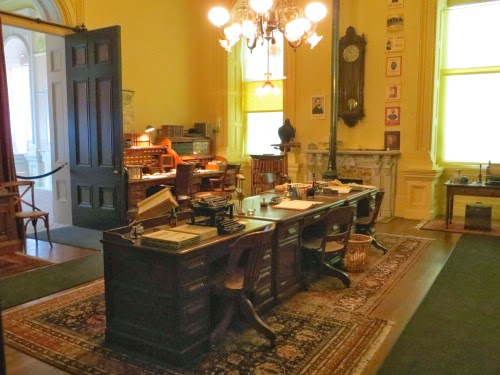
After the Capital, we walked about 3 blocks over to the Leland and Jane Stanford Mansion. Stanford was one of the 4 men who financed and built the Central Pacific Railroad and was the governor of California from 1862 - 1863. He lived here during his term and 2 subsequent governors also used this residence as their Governor’s Mansion.
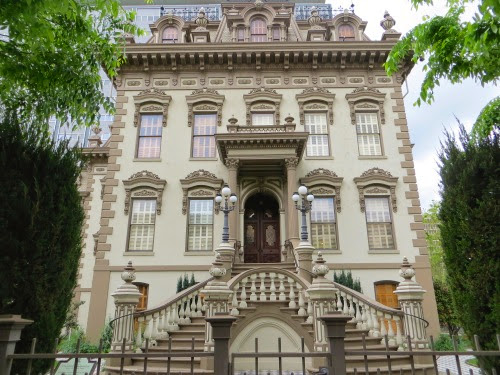
We couldn’t take pictures of the inside of the mansion which has been refurbished in the period when the Stanford’s lived here except for a few rooms which represent a period when the house was used as an orphanage.
Jane Lathrop Stanford gave birth to their only child, Leland, Jr., here on May 14, 1868. The couple’s new wealth enabled them to expand the mansion several times, always adding rooms until they had expanded the original 4000 sq. f home to 19,000 sq. ft. They had several other homes in which they also lived. When Leland, Jr. was traveling with him mother in Europe, he contracted typhoid fever and died shortly after this. The Stanfords decided that, if they could not give their son an education, they would give it to others and founded Stanford University.
In 1900 Jane Stanford gave the mansion to the Catholic Diocese of Sacramento, with an endowment of $75,000 in railroad bonds, for the “nurture, care and maintenance of homeless children.” The Sisters of Mercy, and later the Sisters of Social Service, adapted the aging building to their needs. As decades passed, the old neighborhood gave way to state office buildings, and the cost of upkeep grew. In 1978 the state of California purchased the property for use as a state park and in 1987, the Stanford Home for Children moved to new facilities in north Sacramento.
We always take tours if they are available where we visit. They are usually fun, educational and can help us focus on some of the important facts and bits of information rather than wandering around. However, sometimes what you learn might not be true. We’ve had two examples recently. In one case we were told at the Railroad Museum that when the Stanfords lost their son they went to the Harvard President to ask if they could place a memorial to him in their commons area. They President told them ‘no’ because that would lead to others asking the same thing and pretty soon, the commons would be filled with memorials. He also told them that endowing a college would cost $1,000,000. Well, if that’s all, they thought, why not endow a college in his memory and that is why they started Stanford University. At the Stanford Mansion, we were told that was an urban legend, cute but not true.
Here we were told that the Stanfords were so bereaved that their 15-yr old son had died that they decided to give to other children the opportunities that their son never had. They donated their land, their fortune and, after Leland had died shortly after the University opened, Jane sold her jewels to help fund the University. Interestingly, Stanford was founded as co-educational when most universities were male, was non-denominational when most were associated with a particular religion and was focused on practical education when most other universities were cultural.
For another example, in the California Capital we were looking at the portraits of the recent governors of California and were told that Arnold Schwartzenegger’s portrait was not hung yet because he still had not given it to the Capital yet. Nope, not true - it hasn’t been hung since it has not been 5 years since he left office. By law it must be 5 years.
Who do we believe? Knowledgeable, trained docents and tour guides sometimes give different stories.
Meanwhile, it is time to return to our car and head home.

No comments:
Post a Comment